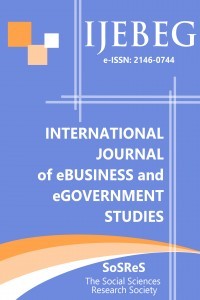A NEW METRIC SYSTEM FOR ASSESSMENT OF E-TRANSFORMATION
A NEW METRIC SYSTEM FOR ASSESSMENT OF E-TRANSFORMATION
Objective evaluation of e-transformation is crucial to shift governments’ e-performance to an advanced level. In this regard, the purpose of this paper is to introduce a new metric system, which takes into account core e-transformation measurement factors to be used for assessing nations’ performance in their adoption of e-transformation. The approach adopts a derived point of view, hence aims to establish a new e-transformation metric system comprising measures of prestigious e-transformation assessment studies. Existing methodologies conducting e-performance assessment have been analyzed and numerous indicators have been reviewed to extract widely recognized measurement factors. Built from literature, the system includes commonly utilized set of metrics under six measurement categories that have impact on e-transformation; “Technology Infrastructure”, “e-Society”, “Human Capital”, “Political and Regulatory Environment”, “Economy Environment”, “Online Services and Applications”. The system is empirically implemented for evaluation and justification. The paper presents implementation of the proposed model by revealing e-performance of thirty countries. Then, the paper demonstrates that proposed system is verified to be used to evaluate countries’ maturity in e-transformation based on implementation results. In other words, the paper confirms that new system has ability to produce e-performance scores highly correlating with those generated by prestigious research institutions.
___
- Akman, I., Yazici, A., Mishra, A., Arifoglu, A. (2005), "E-government: a global view and an empirical evaluation of some attributes of citizens", Government Information Quarterly, Vol. 22 pp.239-57.
- Aldrich, D., Bertot, J.C., McClure, C.R. (2002), "E-government: initiatives, developments, and issues", Government Information Quarterly, Vol. 19 pp.349-55.
- Al-Osaimi, K., Alheraish, A., & Bakry, S. H. (2006). An integrated STOPE framework for e- readiness assessments. 18th National Computer Conference 2006.
- Andersen, K.V., Henriksen, H.Z. (2006), "E-government maturity models: extension of the Layne and Lee model", Government Information Quarterly, Vol. 23 pp.236-48.
- APEC Readiness Initiative. (2000). APEC E-Commerce Readiness Assessment Guide
- Arifoğlu, A. (2004). eDönüşüm Yol Haritası, Dünya, Türkiye. Ankara: Sas Bilişim Yayınları.
- CapGemini. (2007). The User Challenge Benchmarking The Supply Of Online Public Services. Diegem: CapGemini.
- Center for International Development. (2000). Readiness for the Networked World A Guide for
- Developing Countries. Cambridge: Harvard University Chen, D. H., & Dahlman, C. J. (2005). The Knowledge Economy, the KAM Methodology and World Bank Operations. Washington : The World Bank.
- CSPP. (2000). Readiness Guide for Living in the Networked World. A Self-Assessment Tool for Communities.
- Darrell, M. W. (2007). Global E-Government. Rhode Island: Brown University Center for Public Policy.
- Deng, H. (2008), “Towards objective benchmarking of electronic government: an inter-country analysis”, Transforming Government People, Process and Policy, Vol. 2 pp.162-176.
- EIU, & IBM. (2008). E-readiness rankings 2008 Maintaining momentum. The Economist Intelligence Unit.
- Gesellschaft für Kommunikations- und Technologieforschung mbH. (2002-2003). Measuring the Information Society in the EU, the EU Accession Countries, Switzerland and the US. Bonn: SIBIS
- Gupta, M. P., & Jana, D. (2003). E-government evaluation: A framework and case study.
- Government Information Quarterly, 365-387. International Telecommunications Union (2003). Digital Access Index, http://www.itu.int/ITU- D/ict/dai/, [Accessed 3.2.2009]
- Jaeger, P.T., Thompson, K.M. (2003), "E-government around the world: lessons, challenges, and future directions", Government Information Quarterly, Vol. 20 pp.389-94.
- Jansen, A. (2005). Assessing E-government progress– why and what. NOKOBIT. Bergen.
- Mani, H. (2002). e-Readiness, Accessed 9.2.2009] http://www.mit.gov.in/download/CHAPTER1_1-14.PDF,
- McConnell International & WITSA. (2001). Ready? Net. Go Partnership Leading the Global
- Economy. McConnell International LLC. Meghnaddesai, Sakikofukuda-Parr, Johansson, C., & Sagasti, F. (2002). Measuring the Technology Achievement of Nations and theCapacity to Participate in the Network Age. Journal of Human Development .
- Obi, T. (2008). The 2008 Waseda University World e-Government Ranking. Tokyo: Institute e
- Government Waseda University. Ojo, A., Janowski, T., & Estevez, E. (2007). Determining Progress Towards e-Government - What are the Core Indicators? Macao: United Nations University - IIST.
- T.R. Turkish Statistical Institute. (2008). 2008 Yılı Hanehalkı Bilişim Teknolojileri Kullanım
- Araştırması Sonuçları. Ankara: T.R. Turkish Statistical Institute. UNDESA/DPADM. (2008). Main Features Reviewed by the United Nations e-Government
- Survey. New York : United Nations. UNDESA/DPADM. (2008). United Nations e-Government Survey 2008, From e-Government to
- Connected Governance. New York : United Nations. United Nations ICT Task Force. (2005). Measuring ICT: the Global Status of ICT Indicators. New
- York: United Nations ICT Task Force World Economic Forum. (2008). Global Information Technology Report 2007-2008. World Economic Forum.
- World Bank. (2009, June 5). Knowledge for Development, http://web.worldbank.org [Accessed 2.2009]
- Başlangıç: 2009
- Yayıncı: Sosyal Bilimler Araştırmaları Derneği
